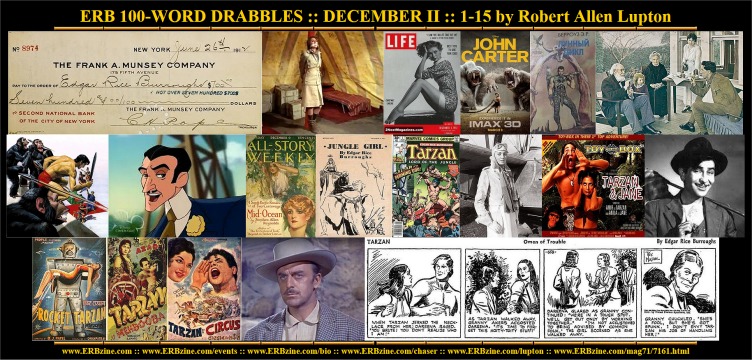
Official Edgar Rice Burroughs Tribute and Weekly Webzine Site Since 1996 ~ Over 15,000 Webpages in Archive Volume 7162  |
ERB 100-Word Drabbles
DECEMBER II Edition :: Days 1 - 15
See Days 16 - 31 at ERBzine 7162a
by Robert Allen Lupton
With Collations, Web Page Layout and ERBzine Illustrations and References by Bill Hillman
SO MANY BOOKS
December 1: On this day in 1911 at approximately 8 PM, according to ERB’s journal, he sat down and began to write “Tarzan of the Apes” in longhand. He originally used the names “Tublat Zan” and “Zantar” for the ape man, but with a simple and fortunate reverse of the syllables, Zantar became Tarzan. Bloomstoke became Greystoke at some point along the way.
The Frank A. Munsey Company bought the novel for The All-Story Magazine, dating a check for $700.00 on June 26, 1912 and neither Tarzan nor Edgar Rice Burroughs ever looked back.
Countless editions of the book have been published around the world. Bob Zeuschner lists 126 American versions in his “Edgar Rice Burroughs The Bibliography” and Jim Goodwin lists 52 versions in “Edgar Rice Burroughs The Descriptive Bibliography of the Ace and Ballantine Paperback Books.” No doubt there are more.
I have 27 foreign editions of the book, from 19 countries. This doesn’t even begin to address daily and Sunday newspaper comics, radio shows, comic books, movies, television shows, games, puzzles, toys, slot machines, costumes, and cartoons. The list is so extensive, that I’m sure I’ve left something out.
Novelist, songwriter, and singer, Kinky Friedman, once said that the three things people around the world can say in English are “Elvis, Jesus, and Coca-Cola,” he even titled a book that. While I admire his writing, I beg to differ. “Tarzan” belongs on that list and probably at the top of it.
Publishing details and numerous illustrations for the story are located at:
SO MANY BOOKS
![]()
“Every edition is different and I have to have all of them.”
“John, the only differences in some of these are the prices and the dates. Several of these hardcovers were printed from the same plates. Some are even the same edition with different colored cloth binding.”
“Even the smallest change makes a new edition.”
“A distinction without a difference. You should be
ashamed.”
“Pat, how many editions do you have?”
“Fifty-four.”
“Now, I understand your attitude. This is just jealousy
clothed in piety.”
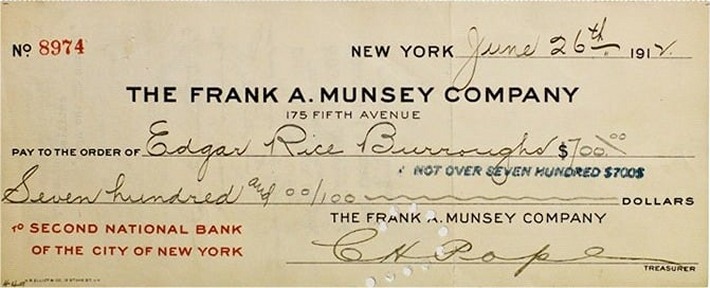
SUZY PARKER
December 2: On this day, episode number twelve of the Ron Ely Tarzan television show, “The Day of the Golden Lion” was broadcast. The episode featured model and actress, Suzy Parker,” in the role of Laura Keller. Suzy is best known for her role in the Twilight Zone episode, “Number 12, Looks Just Like You.”
Suzy’s photo appeared in Life Magazine when she 15 years old when she began her professional modeling career. For a period of time, she was the face of Coco Chanel. She was the first model to earn $200.00 an hour and $100,000 a year. She appeared on the covers of over 70 magazines around the world including Vogue, Elle, Life, Look, Redbook, and McCall’s.
She made appearances in about two dozen television shows. While she didn’t appear in The Beatles’1970 documentary film, “Let It Be,” the film included their song “Suzy Parker,” one of the few credited as written by all four Beatles and the song was part of their Academy Award-winning score for the film.
Parker was married three times. Her marriage to actor Bradford Dillman in 1963 lasted until her death in 2003.
What could be more fitting for today’s drabble than the deathless lyrics to the Beatles’ song “Suzi Parker.” I remind you that all four of the fabulous four received writing credits for the tune. If you want to hear the song – Suzy Parker
SUZY PARKER
![]()
Well come on Suzy Parker, everybody's welcome to come
(Come on, Suzy Parker, come on Suzy Parker)
Said come on Suzy Parker, everybody's welcome
to come
(Come on Suzy Parker, come on Suzy Parker)
When you get on Suzy Parker everybody gets well
done
I said come on Suzy Parker, everybody's welcome
to come
(Come on Suzy Parker, come on Suzy Parker)
I said come on Suzy Parker, everybody's welcome
to come
(Come on Suzy Parker, come on Suzy Parker)
Yeah you come to Suzy Parker, everybody gets
well done
When you get on Suzy Parker everybody gets well done
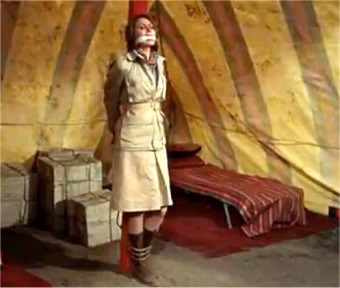

NAME FOR THE MASSES
December 3: On this day in 1984, the Union Carbide Fire in India killed actress Shakeela Bana Bhopal along with thousands of other people. Shakeela starred in three Bollywood Tarzan Films, Rocket Tarzan, Tarzan and Hercules and Tarzan aur Jadui Chirag.
Shakeela deserved a mention, but she’s not the subject of today’s article. Fifty-five years ago on this in 1965, Andrew Stanton was born in Boston, Massachusetts. Stanton, who was one of the men who made Pixar a leading animation studio, directed the $250 million dollar live action Disney film, “John Carter.”
His film work includes co-writing Pixar’s “A Bug’s Life” (1998) (as co-director), “Finding Nemo” (2003) and the sequel “Finding Dory” (2016),and “Wall-E” (2008, He also co-wrote all four Toy Story films (1995-2019) and “Monsters, Inc. (2001).
Finding Nemo and WALL-E earned Stanton Academy Awards for best animated feature. On television, Stanton directed two episodes of “Stranger Things” in 2017, an episode of “Better Call Saul” in 2018, and the final season premiere of “Legion” in 2019.
The website, Collider reports the following:
Director Andrew Stanton recently told the website BleedingCool that the title had already been changed from A Princess of Mars because it was a "truth" that boys wouldn't go see it if they kept author Edgar Rice Burroughs' original title. But then, when they changed it to John Carter of Mars, Stanton believed it was also a "truth" that girls wouldn't see it because apparently girls hate planets. So the compromise was to make it John Carter and now no one will see it.
He had to be right. Apparently the millions of readers who purchased the book over the last hundred years were wrong.
The drabble for today is “Name for the Masses.”
NAME FOR THE MASSES
![]()
“I don’t understand. “A Princess of Mars” sold millions of books.”
“Disney owns the “Princess franchise.” Men and boys won’t go see princess films. We’ll call it “John Carter.”
“Andrew, Mars belongs in the title.”
“Girls don’t like space stuff.”
A female publicist threw down her tablet. “Tell that
to the female pilots, scientists, and astronauts. There’s women on the
Supreme Court. This isn’t a cartoon.”
“Stop it. You need to lose the attitude and change the damn title. No Mars and no princess.
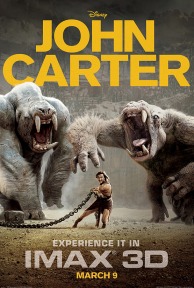
EVERYONE'S A CRITIC
December 4: On this day in 1918, Edgar Rice Burroughs submitted a proposal to the Department of Justice. He planned to alert the American people to the dangers of being governed by Bolsheviks (Communists) by writing a fictionalized account about life under Bolsheviks rule.
Burroughs requested background information so his novel would be as accurate as possible, but the Department of Justice refused to help, instead the chief of the Chicago bureau of the Department of Justice (Federal Bureau of Investigation,) a man named Hinton G. Clabaugh wrote back to Burroughs and told him, thanks, but no thanks. He declined to provide any information and suggested that Burroughs abandon the entire project - basically to leave the government’s strategy to the people in charge.
Burroughs ignored Calbaugh’s instructions and wrote the book anyway -- eventually expanding the story into a trilogy. The result was “The Moon Men.’ ERB then wrote “The Moon Maid” to set up the “The Moon Men,” and finally the “The Red Hawk,” to evict the Bolshvikian Moon Men from the Earth.
Hinton G. Clabaugh, was head of the Federal Bureau of Investigation in Chicago during the first World War and the former head of the Illinois Board of Pardons and Paroles. He died on June 1, 1946 in Evanston Hospital, Evanston, Ill. His age was 63.
The drabble for today, “Everyone’s A Critic,” was inspired by Edgar Rice Burroughs and his contact with the Department of Justice.
EVERYONE'S A CRITIC
![]()
“That’s great, Dad. I remember when that guy at the
FBI told you abandon the entire project.”
“Hinton Clabaugh. His letter made me so upset, that
I was determined to write the books and the Department of Justice be damned.”
“Well, I’m glad it turned out well. I loved Na-ee-lah,
the heroine. She was one tough cookie.”
“Thank you. I hope that Clabaugh was better at catching
crooks than he was at evaluating a story proposal.”
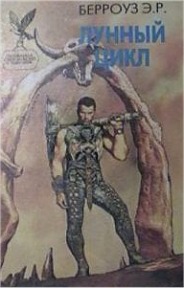
NO FREE LUNCH
December 5: On this day in 1941, The Rex Maxon and Don Garden Tarzan daily comic strip storyline, “Lost On An Island,” concluded. The feature began on July 31, 1941 and ran for 110 episodes. It was preceded by “The Jungle Idol” and continued in “The Path of the Lions.” Maxon and Garden were a team on the Tarzan daily strip from August 13, 1934 until August 31, 1935. After a brief hiatus, they returned on January 17, 1938 and remained with the strip until Don Gardner left on November 27, 1943. Maxon continued the Tarzan daily alone from then until August 30, 1947 – another 1224 daily episodes.
The entire storyline may be read online at: https://www.erbzine.com/mag47/4768.html
The drabble for today is “No Free Lunch,” and it’s based on that episode, and the works of Edgar Rice Burroughs.
NO FREE LUNCH
![]()
Tarzan and an old pioneer woman, Granny Akers, put the passengers on a lifeboat. It overturned in the storm. The survivors swam to shore.
Dareena, a woman of privilege, refused Tarzan her necklace to make fishhooks. Granny Akers said, “Woman, do your part. You either fish, hunt, and search for fruit and vegetables or you can fondle your jewelry while you starve.”
“No one talks to Dareena like that.”
“Pay attention, my pampered princess. It’s like the ant and the grasshopper. Them what don’t work, don’t eat.”

THANK YOU FOR YOUR SERVICE
December 6: On this day in 1917, The New Oxford Item, a newspaper in New Oxford, Pennsylvania, published a 400 word article by Edgar Rice Burroughs, “To The Mother.” The article is a story about a woman who opened her home to a lonely soldier preparing to go to Europe and fight in World War One.
Burroughs, ever a champion of the brave men in the armed services, suggests that by opening homes to soldiers, men may be saved from falling in activities of moral turpitude or falling victim to violence.
A photocopy of the article and a transcription of the text are available at:
The drabble for today is 100 words written by Edgar Rice Burroughs and excerpted from that article. Let’s call it “Thank You For Your Service.”
THANK YOU FOR YOUR SERVICE
![]()
Suppose another sort of woman accosted him? You can do the same for some other boy in uniform. You can open your house to him. You can save him as surely as that other woman saved the boy in Chicago. Association with these boys keeps them from evil. It’ll inspire you with the high ideals which dominate the men of the army.”
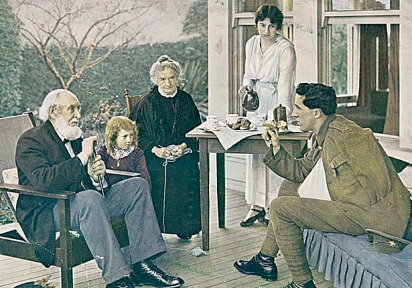
FOLLOW THE MONEY
December 7: On this day in 1999, comic book artist, George Wilson died. George Wilson, not the George Wilson who was Dennis Mitchell’s neighbor, was one of Gold Key’s finest cover artists. His realistically painted covers always grabbed the attention of young readers, I know they grabbed mine. He painted covers for Tarzan, Korak, Turok, Space Family Robinson, Magnus, Robot Fighter, The Phantom, Dark Shadows, Star Trek, Dr. Solar, Boris Karloff, Ripley’s Believe it or Not, King Kong and Twilight Zone. I’m sure I've missed several more.
Wilson said he was inspired by the classic Alex Raymond Flash Gordon illustrations. George Wilson worked in commercial illustration before and after his years with Western Publishing (Gold Key), and he illustrated numerous Hardy Boys books, as well as several romance, war and western paperbacks. He was in strong demand by advertising agencies because of his realistic style.
His lush watercolor and acrylic paintings for Gold Key comic’s science fiction, jungle, mystery, and adventure titles were classics.
He rarely signed his work. He drew his illustrations based on a brief synopsis from the writer. Frequently actor, Steve Holland (Holland played Flash Gordon in the 1954 television series) posed for the hero images.
Here’s the illustration for one of Wilson’s Tarzan covers.
The drabble for today is “Follow the Money.”
FOLLOW THE MONEY
![]()
“In those days, comic illustrators executed “Work For Hire” agreements. Simply, I got paid one time. Western Publishing didn’t give me credit and they kept all rights and the originals. No point is signing anything.”
“Is that why you started doing paperback covers and
advertisements?”
“Partially. Paperbacks were still “Work For Hire”
with higher pay. Advertising was the gift that keeps on giving. I got paid
a little with every printing and checks arrived daily. God bless Noxzema.”
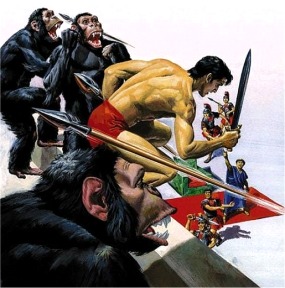
BAD INTENTIONS
December 8: On this day in 2019, actor Rene Auberjonois died from metastatic lung cancer at his home in Los Angeles. Rene is best remembered for his long time roles as Odo on “Star Trek Deep Space Nine,” “Clayton Edicott lll on “Benson,” and Paul Lewiston on “Boston Legal.” He voiced the character, Rene Dumont, the owner of Dumont’s Trading Post, in Disney’s “Tarzan and Jane” direct to video and in twelve episodes of television’s animated “Legend of Tarzan” series. His smooth talking charlatan of a character was infatuated with Jane, and always seeking a way to take advantage of the unwary.
Auberjonois appeared in numerous television shows including “The Outer Limits.’ “Star Trek Enterprise,” “Wonder Woman,” “The Bionic Woman,” and “Star Gate SG-1.” He had roles in 40 films and created the character, Father John Patrick “Dago Red” Mulcahy in the film M*A*S*H.
Auberjonois was a regular on Broadway and won a Tony award for his role in “COCO,” where he appeared with Katharine Hepburn.
Besides voicing Rene Dumont in Disney’s Tarzan animation series, he voiced characters in nearly 100 animation films, television series, and video games.
Today’s drabble, “Bad Intentions,” is based on the works of Edgar Rice Burroughs, the list of villains who pursued Jane, and Rene Auberjonois’ character, Rene Dumont. I can still hear his sleazy voice. Reminded me of Eddie Haskell.
BAD INTENTIONS
![]()
Tarzan grabbed the smooth-talking sharp dressed trader by the throat. “Jane says that you keep annoying her and flirting with her. She’s my wife. Touch her and I’ll kill you.”
“Monsieur Tarzan, calm down. This is a misunderstanding. I would never behave inappropriately toward Jane. I don’t even like her.”
Tarzan shook Dumont and said, “What, you little piece of monkey poop, are you saying that Jane’s not good enough for you.”
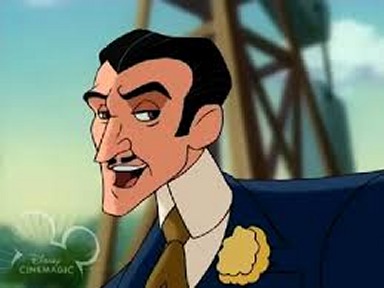
SMALL SACRIFICE
December 9: On this day in 1916, All-Story Weekly published the fourth part of the five part serialization of “Tarzan and the Jewels of Opar.” The Patrick Monahan cover for the first installment, published November 18, 1916 featured a blondish Tarzan and was the only All-Story cover during run to feature Tarzan. The cover for the December 9th issue featured an illustration for “Mid-Ocean,” a South Pacific romance of two castaways, written by Stephen Allen Reynolds (Stephen Allan), author of “The Tri-Colored Tusk,” “Beyond the Timberline,” “Celtic Warrior,’ and over 100 more pulp adventures and romances.
“Tarzan and the Jewels of Opar” is likely my favorite Tarzan novel. Opar was the first of many ancient civilizations that Tarzan encountered. Tarzan first visited Opar in “The Return of Tarzan,” but I enjoyed “Jewels” much more.
For a historical perspective, consider the book, “Song of Opar,” written by Jim Matachowski: https://www.erbzine.com/mag64/6420.html
Available on Amazon.com
I strongly recommend the books about ancient Opar written by Philip Jose Farmer and Christopher Paul Carey:
www.meteorhousepress.com
The drabble for today. “Small Sacrifice,” is based on “Tarzan and the Jewels of Opar,” and is taken from the publishing blurb on the first Ballantine paperback edition of the book.
SMALL SACRIFICE
![]()
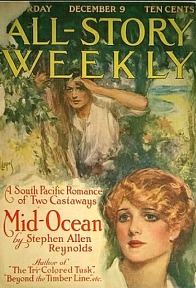
December 10: On this day 87 years ago in 1933, The Boston Post Sunday began to serialize ERB's "Jungle Girl." It was not unusual for newspapers to serialize novels in those days as a method to increase their circulation. The Dallas Journal serialized “The Fighting Man of Mars,” the Humestown, Iowa’s New Era published “A Princess of Mars” in 1921, and “The New York Evening World published “The Maneater” in six parts in November 1915. These three are only examples, there are several more.
The Boston Post Sunday featured an illustration by Tarzan comic illustrator Rex Maxon of the classic scene of Fou-tan riding in a howdah atop the elephant. It’s interesting how often different illustrators choose the same scene from a book to illustrate. “A Mastermind of Mars” is a classic example.
Burroughs’ working title for the book was “The Dancing Girl of the Leper King.” Blue Book Magazine and Ace Books published the story as “The Land of Hidden Men.”
https://www.erbzine.com/mag7/0776.html
ETERNAL QUEST
![]()
Fou-tan replied, “The jungle has a thousand eyes. Some belong to the King’s warriors, some to mighty beasts of prey, and some to the elusive hidden men.”
Gordon jumped and pointed his pistol at every bird call, monkey howl, or windblown movement in the forest. “Why are they hiding? What do the hidden men want?”
“They want to find hidden women."
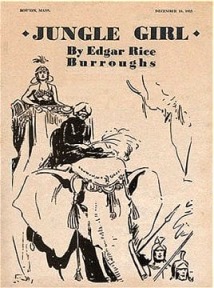
MAN'S GOTTA DRAW
December 11: On this day in 1927, comic book artist, John Buscema, was born as Giovanni Natale Buscema in Brooklyn, New York. A mainstay with Marvel Comics, Buscema penciled “The Avengers,” “The Silver Surfer,” and over two hundred issues of “Conan the Barbarian.” He penciled almost every Marvel character at least once and had long runs drawing “Fantastic Four” and “Thor.”
When Marvel gained the rights to “Tarzan” in 1977, they titled the comic “Tarzan, Lord of the Jungle. The series, written by Roy Thomas, with artwork by John Buscema, ran for 29 issues and three annuals. All of Buscema’s “Tarzan, Lord of the Jungle” covers are available at
Today’s drabble, “Man’s Gotta Draw,” is taken directly from an interview with Sal Buscema, John’s brother.” The entire interview is available HERE
MAN'S GOTTA DRAW
![]()
This guy used to eat, sleep and breathe drawing. It didn't matter what was going on around him. He would get bored with it and start sketching.
... He just couldn't stop drawing. His back-of-board sketches were better than some of the stuff on the front.
... He'd get a spark of inspiration and turn the page over and draw whatever was in his skull.”
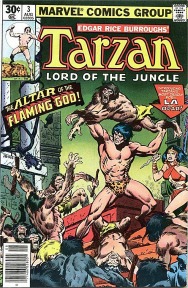
A QUESTION OF PRIORITY
December 12: On this day in 1952, actress Sarah Douglas was born in Stratford-upon Avon in Warwickshire, England. She is best remembered as the super-villainess, Ursa, from Superman and Superman II. She made two screen appearances in Edgar Rice Burroughs related productions. First, she appeared in ”The People That Time Forgot” in 1977, playing a photographer, Lady Charlotte (Charly) Cunningham, sporting a Princess Leia hairdo. She also appeared in one Wolf Larson “Tarzan” 1993 television episode, playing Kiki Bluett in “Tarzan and the Fountain of Youth.”
Her work includes roles in “Conan the Destroyer,” “Falcon Crest,” “Rollerball (1975), “Magnum PI,” “Remington Steele,’ “Babylon 5,” “Stargat-SG1,” “Solarbabies,” The Return of the Swamp Thing,” and the classic 2012 film, “Strippers vrs. Werewolves.”
She has voiced several animated features including “Green Lantern,” “Iron Man,” “The Real Adventures of Jonny Quest,” “Heavy Gear,” and “Batman Beyond."
It should also be noted that she toured the United Kingdom in “Hamlet” in 2003. Still active, she was in the 2019 film “A Christmas Prince: The Royal Baby,” and on television as Victoria Parker in “Holby City,” that same year.
One quote by Sarah Douglas is appropriate to accompany today’s drabble, “When we decide to see things one way we are often incapable of seeing them any other way.”
Today’s drabble is “A Question of Priority” was inspired by Edgar Rice Burroughs and the film “The People That Time Forgot.”
A QUESTION OF PRIORITY
![]()
“Possibly, but I must have photographic evidence of life on Caprona. I’ll be famous once I sell my pictures of dinosaurs and cavemen. I refuse to return empty handed.”
“You’re endangering us all. Just keep a written journal."
“I do keep a journal, but it isn’t enough. You know
that a picture is worth a thousand words.”
“I know that fame is of no value to the dead.”
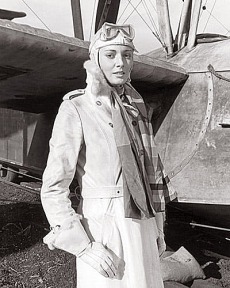
JUNGLE BOOGIE
December 13: On this day in 1940, Edgar Rice Burroughs finished writing the 37,000 word story, “The Quest of Tarzan.” The story was serialized by Argosy Weekly in three installments beginning on August 23, 1941. At book publication by Canaveral Press for the 1965 first edition, the title was changed to avoid confusion with the novel, “Tarzan’s Quest,” and it was published in hardcover as “Tarzan and the Castaways.”
“Tarzan’s Quest,” a 72,000 word novel was written in 1934 and 1935, under the working title of “Tarzan and Jane.” The story was published in Blue Book Magazine as “Tarzan and the Immortal Men,” leaving the title “Tarzan and Jane” unused and available for Disney to use for a direct to DVD animation film combining three unreleased episodes of the animated Tarzan television series, “The Legend of Tarzan,” not to be confused with the Canadian – American television series, “Tarzan and Jane,” a computer animated series produced by Arad Animation and released on Netflix in 2017.
Are you confused about the titles yet? I hope you paid attention. At some point there may be a test.
Wait, I missed one thing in this chain of inter-related titles. The Danish bubblegum dance group, Toy-Box, released the song, “Tarzan and Jane” on November 12, 1998 as the lead song in their debut album, “Fantastic.” It was re-released n 1999 to coincide with the premier of Disney’s Tarzan film and became a top 10 hit in Denmark, Norway, and Sweden – reaching #15 on the Eurochart Hot 100. It was also a hit in New Zealand and Australia. The song was released in America, but it never caught on.
I apologize, but couldn’t resist using the deathless lyrics of the song as today’s drabble, “Jungle Boogie.”
JUNGLE BOOGIE
![]()
“My name is Tarzan I am jungle man
The tree tops swing-a from jungle land
Come baby come I will take you for a swing
Let's go honey I'm tink-a-ling
Tarzan handsome, Tarzan strong
He's really cute and his hair is long
Tarzan handsome Tarzan strong
So listen to the jungle song
I’m Tarzan from jungle you can be my friend
I’m Jane and I love to ride an elephant
When you touch me I feel funny
I feel it too when you're touching me
Come to my tree house to my party
Yes, I'll go if you carry me”
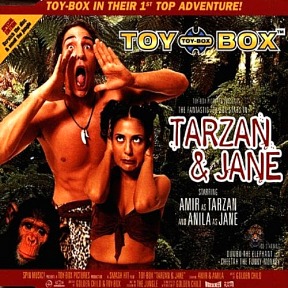
TELL ME A LOVE STORY
December 14: On this day in 1924, actor, screenwriter, and director, Shrishti Nath Kapoor, known professionally as Raj Kapoor, was born in what was then, British occupied Peshawar in the North Western Frontier Province of India.
He is widely regarded as the greatest showman in the history of Indian cinema and entertainment. He received three National Film Awards and 11 Filmfare Awards in India. The Filmfare Lifetime Achievement Award is named after Kapoor. He was a two-time nominee for the Palme d’Or grand prize at the Cannes Film Festival His films attracted worldwide audiences, particularly in Asia and Europe.
The Indian government honored him with the Padma Bhushan for his contributions the arts and India's highest award in cinema, the Dadasaheb Phalke Award, was bestowed on him in 1987 by the Government of India.
Raj appeared in three Bollywood Tarzan films that I know of. He appeared in “Rocket Tarzan” (1963), “Tarzan and Circus” (1965) and “Tarzan Ki Mehbooba” (1966), aka “Tarzan My Beloved.”
The poster from the film, "Rocket Tarzan," owes a lot to Forbidden Planet. Just saying.
The drabble for today is “Tell Me a Love Story.” The quotes by Raj Kapoor are real.
TELL ME A LOVE STORY
![]()
“Some people don’t understand the world is universal now. My shoes are Japanese, these pants are British, I have a Russian red hat on my head, but still my heart is Indian.”
“Why are your films successful worldwide?”
“People around the world understand love. Love is
universal. There is a heart in every human and in every human there is
a heart. I am a heart merchant – I buy hearts and I sell hearts.”
“Even your Tarzan films?”
“What is Tarzan – if not a love story?”
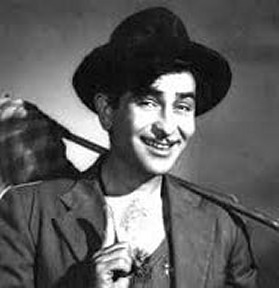
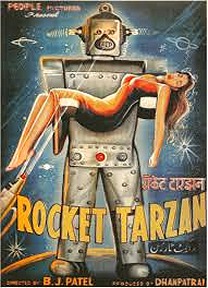
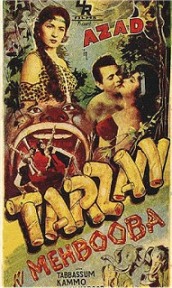
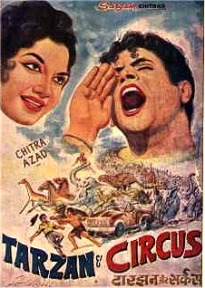
SLEEPING RUBY
December 15: On this day in 1967, actor John Dehner was the guest star on Season Two, episode number 13 of Ron Ely’s Tarzan television show, titled, “Jai’s Amnesia.”
Jai suffered amnesia and was manipulated by a scheming drifter, played by Dehner, and his no-good cohorts into helping them steal a sacred ruby. Tarzan foiled their plans.
Over a 45-year movie career between 1940 and 1986, Dehner appeared in no fewer than 260 television episodes, feature films, and shorts. He played Sheriff Pat Garrett in “The Left Handed Gun” opposite Paul Newman’s Billy the Kid. John Dehner’s face is familiar to everyone who was a fan of films and television, even though his name may not be.
Besides his role in “Jai’s Amnesia,” he appeared in 1943’s “Tarzan’s Desert Mystery” as Prince Ameer. So 14 years between roles in a Tarzan feature.
Today’s drabble is “Sleeping Ruby,” and it’s based on the episode, “Jai’s Amnesia,” and as always, is inspired by the works of Edgar Rice Burroughs. A tip of the hat to Flip Wilson.
SLEEPING RUBY
![]()
Inside the church, Crosby said. “Search everywhere.
A flower is engraved on the ruby.”
He slapped one man inspecting a clapper. “Idiot. The
ruby begonia doesn’t ring a bell.”
Tarzan intervened before they found the jewel. Crosby
complained, “We searched everywhere.”
A priest opened a compartment hidden in the arm of
saint’s statue. “Not quite everywhere. Ruby is only skin deep.”
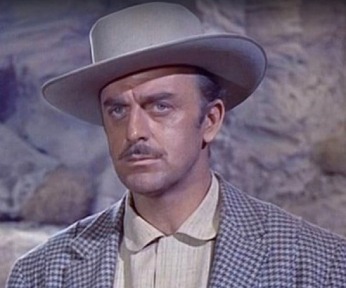
![]()
![]()
See
Days 16-31 at ERBzine 7162a
![]()
DECEMBER II ILLUSTRATIONS COLLAGE
![]()
